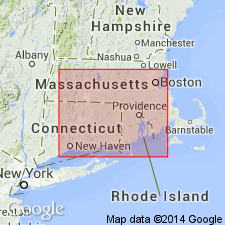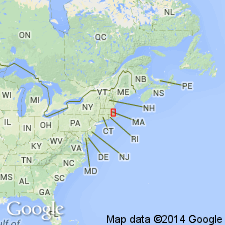
- Usage in publication:
-
- Sandy Pond Amphibolite Member*
- Modifications:
-
- Age modified
- AAPG geologic province:
-
- New England province
Summary:
By inference due to age change of Marlboro Formation, age of Sandy Pond Amphibolite Member changed from pre-Silurian (Precambrian Z(?) to early Paleozoic) of Bell and Alvord (1976) to Proterozoic Z, Cambrian, or Ordovician based on radiometric age determinations and stratigraphic relations [not clearly explained].
Source: GNU records (USGS DDS-6; Reston GNULEX).

- Usage in publication:
-
- Sandy Pond Amphibolite Member
- Modifications:
-
- Not used
- AAPG geologic province:
-
- New England province
Summary:
Although Marlboro Formation is used, its Sandy Pond Amphibolite Member is not used on this map. [No explanation given.]
Source: GNU records (USGS DDS-6; Reston GNULEX).

- Usage in publication:
-
- Sandy Pond Member*
- Modifications:
-
- Overview
- AAPG geologic province:
-
- New England province
Summary:
Used as Sandy Pond Member [inadvertently used, should have been Sandy Pond Amphibolite Member] of Marlboro Formation in Nashoba zone. Bell and Alvord (1976) divided the Marlboro into an unnamed lower member of mica schist, calc-silicate rock, marble, and amphibolite, and the upper Sandy Pond [Amphibolite] Member. Skehan and Abu-Moustafa (1976) divided Marlboro into 31 unnamed members (M1-M31) based on mapping in the Wachusett-Marlborough tunnel; most of the amphibolite is in lower part of the section, compared with Bell and Alvord's mapping. Hepburn and DiNitto (1978) and Hepburn (1978) recognized four divisions based on mapping of surface rocks above the tunnel in Marlborough and Shrewsbury area; one of their divisions is the [informal] Sandy Pond amphibolite member, which coincides with Bell and Alvord's Sandy Pond and with amphibolitic lower part (units M1-M16) of Skehan and Moustafa's section. It appears that all three amphibolites are equivalent. Age is Proterozoic Z or Ordovician, although author believes that majority of metasedimentary rocks in Nashoba zone are Proterozoic. [No formal age change made in this report. Does not explain why Sandy Pond was not used on MA State bedrock map of Zen and others, even though chapters A-J in U.S. Geological Survey Professional Paper 1366 are intended as explanations and (or) revisions to 1:250,000-scale MA State bedrock geologic map of Zen and others (1983).]
Source: GNU records (USGS DDS-6; Reston GNULEX).
For more information, please contact Nancy Stamm, Geologic Names Committee Secretary.
Asterisk (*) indicates published by U.S. Geological Survey authors.
"No current usage" (†) implies that a name has been abandoned or has fallen into disuse. Former usage and, if known, replacement name given in parentheses ( ).
Slash (/) indicates name conflicts with nomenclatural guidelines (CSN, 1933; ACSN, 1961, 1970; NACSN, 1983, 2005, 2021). May be explained within brackets ([ ]).

